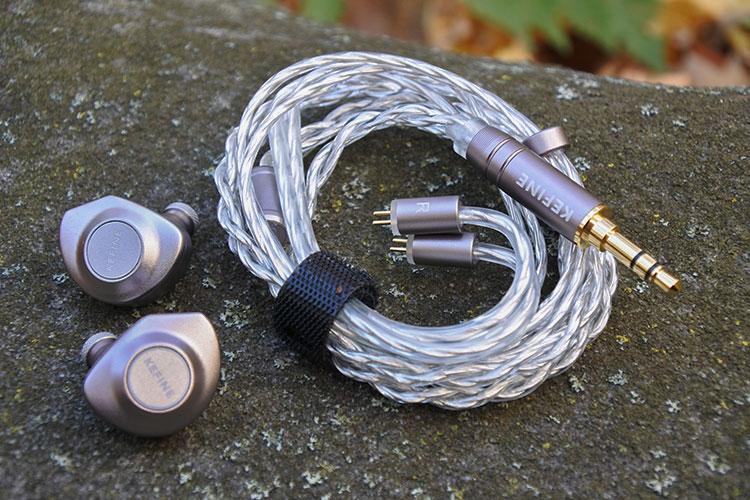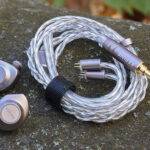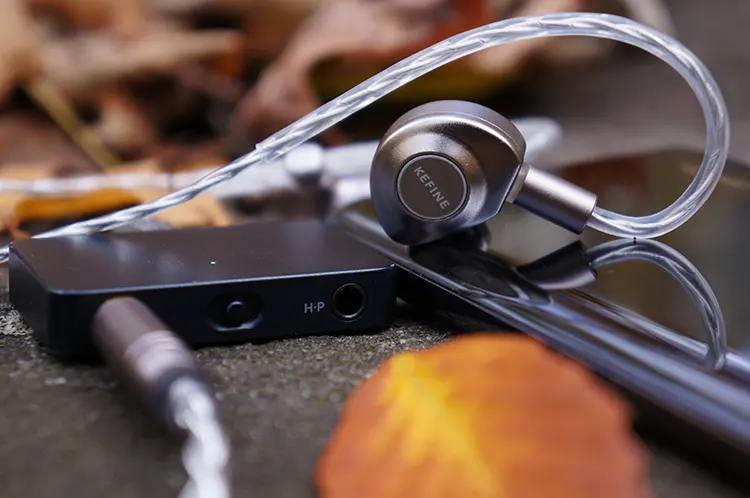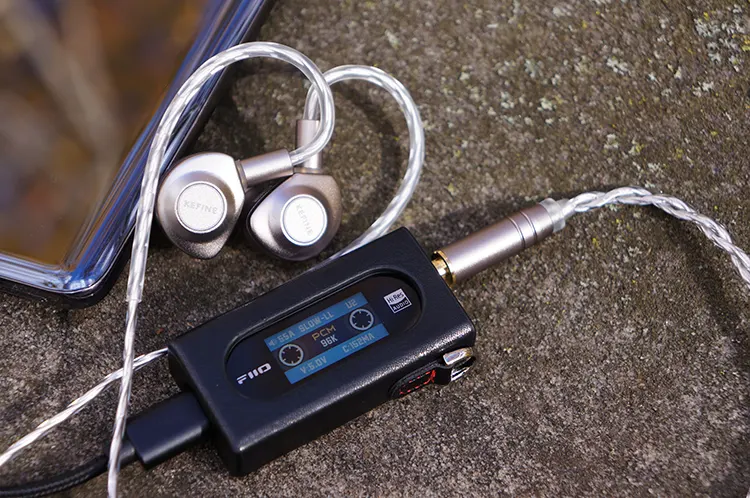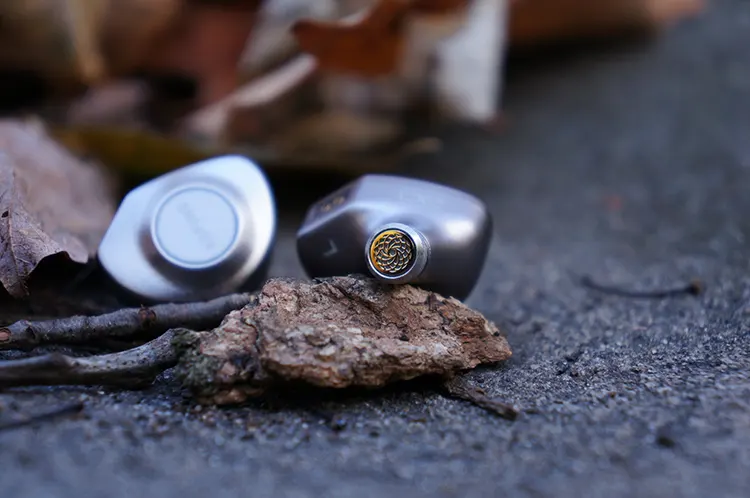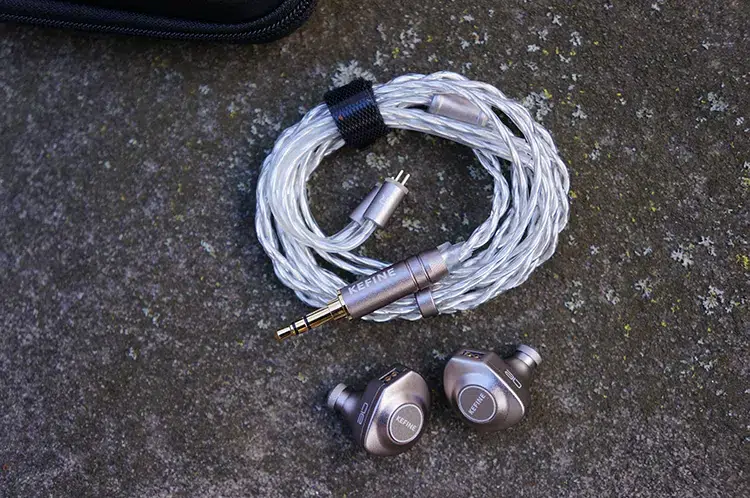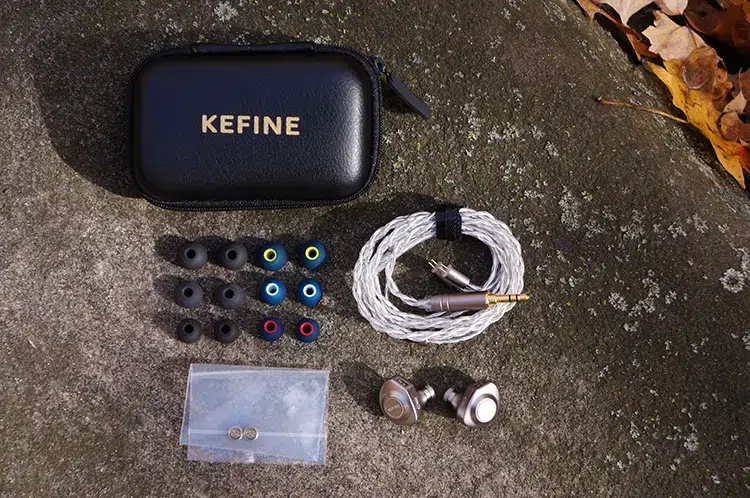Today, Thomas reviews the KEFINE Delci AE, an enhanced edition of the original single 10mm dual-cavity dynamic driver IEM with a dual-tone nozzle. It is priced at $89.
Disclaimer: This sample was sent to me in exchange for my honest opinion. Headfonics is an independent website with no affiliate links or status. I thank KEFINE for their support.
To read more about KEFINE products we have previously featured on Headfonics click here.
Please note, that this article follows our current scoring guidelines, which you can read in more detail here.
Earlier in the year, I reviewed the original KEFINE Delci IEM. I found it a “great listening experience” thanks to a strong low end, clean mids, and just enough treble sparkle to make it a well-rounded performer.
Through Kefine’s collaboration with Angelears, the new $89 Delci AE has been upgraded with a fresh silver-plated cable and a tuning filter system with two options. It slots between the Klanar and standard Delci in Kefine’s IEM lineup.
The Delci AE’s upgrades over the standard Delci do not result in a drastically different user experience and end up being more of a side grade. Still, the Delci AE remains a competitive entry-level IEM and my pick of the two when deciding which one to purchase.
Features
The Delci AE features the same 10mm dynamic driver as the original Delci. That also means the original’s polyurethane composites and a dual-cavity configuration for enhanced bass and staging performance returns.
Also carried over is machined aluminum housing. While the size and ergonomics are the same, the Delci AE comes in a new silver color scheme, and its weight has increased a fraction of a gram thanks to the new tuning filter system absent on the original Delci.
Along with the tuning filters is a new cable. The Delci’s bi-color, quad-strand copper cable has been replaced with a slightly lighter, dual-strand silver-plated model terminated in either 3.5mm single-ended or 4.4mm balanced options.
Design
Unsurprisingly, the Delci AE shares its design with the original Delci. The shells have swapped to a new silver colorway but provide the same low-profile fit, lightweight, and thoughtful ergonomics.
The interior of each shell lacks sharp edges and is silky smooth, with the nozzles curving out from the main body. The pinhole vent locations remain unchanged and can be found near the base of each nozzle, with another located further up near the L/R markers.
The tips of the nozzles can now be screwed off so you can swap between two filters for different sound signatures.
Both filters feature the same ornate metal grills used on the original Delci with the pre-installed set using the same silver coloring, while the second set has gold coloring.
The threading is well done with both sets screwing on smoothly and easily. One potentially critical mistake is that they lack rubber gaskets to ensure secure seating so they can loosen unexpectedly.
The same 2-pin ports return with a common 0.78mm sizing and design that sits flush with the housing. It provides solid pin protection and allows proper fitment of third-party cables.
The silver anodized finish is smooth and blemish-free, with more even spacing between the two halves of the shell compared to the original Delci. This improvement to fit and finish is a small but welcome step up in quality.
Comfort & Isolation
Thanks to the lightweight and low-profile design of the Delci AE, this is a comfortable product to wear for long periods. The weight is distributed evenly around the outer ear, and the lack of hard or sharp edges avoids uncomfortable hot spots.
With the original Delci, I found the left ear regularly lost its seal, which to my surprise has not been an issue with the Delci AE. The fit was consistent, requiring minimal reseating, even during heavy activity.
The preformed ear guides do a better job of keeping the cable securely up and around the back of the ear than the original Delci. I suspect this is due to the lower cable weight, fewer and more flexible strands, and improved shaping of the guides.
Isolation from the Delci AE is average due to the dual vents and relatively shallow fit of the low-profile shells. A volume increase was needed to counter noise bleed in busy areas, though not so much as to cause discomfort or necessitate dangerous listening levels.
Ear Tips
For the Delci AE, the medium bore tips included with the standard Delci have been replaced with a color-coded set whose bore is slightly wider than the default small-bore set.
They sounded nearly the same and provided a decent seal, though I found third-party options to offer a better fit.
My usual go-to tips from JVC, Sony, and Final Audio provided a solid seal, though they never felt as secure as on other models. The SpinFit CP100 and CP145, which worked great with the original Delci, were superior picks here too.
The CP100 did a good job mimicking the stock tips, while the CP145 reduced the mid-bass and lowered the treble emphasis.
The latter, paired with the gold filters, was especially nice, removing some treble grain while retaining most of the additional energy the filter brings.
ADV-Sound’s Eartune Fidelity U in its largest size was my preferred set with the Delci AE. The elliptical shape permitted the most reliable seal while sounding as good as the SpinFit CP145.
For those who like the stock tips but want higher-quality alternatives that provide a more reliable seal, I recommend the Fidelity U and CP145 for a less bassy, more energetic sound, and Sony Hybrids or Final Type E to replicate the stock tips’ signature.
Stock Cable
Angelears ensured the Delci AE’s new cable improved the quality of the original Delci. The new wiring is silver-plated and installed in a dual-strand configuration, with the original hardware making a return, now in the same silver colorway as the earpieces.
The hardware is quality, with a gold-plated straight jack, metal y-split with chin cinch, and metal surrounds on the 0.78mm 2-pin plugs. Strain relief is still a weak spot, even if incrementally improved over the Delci’s cable.
While weight savings are only a fraction of a gram, the new cable is more flexible, even more resistant to microphonics, and just as memory and tangle-resistant. It’s pleasant to use on the go, even if the sheath stiffens considerably in the cool Canadian weather.
Beyond wanting more effective strain relief, I have nothing bad to say about this cable. It looks nice, and the handling characteristics are outstanding.
Packaging & Accessories
The packaging for the Delci AE is similar to the original Delci, updated to reflect the new features and Angelears collaboration.
The front of the sheath displays Kefine and Angelears branding, along with an image of the Delci AE earphone and its new cable. The back lists the specifications and key features like the tuning system, driver technology, and CNC machining process.
Inside, a plain matte-black cardboard box with Kefine branding holds the contents. Upon opening, a foam insert secures the earpieces, and a carrying case contains the additional accessories.
These include a Velcro cable strap, color-coded medium-bore tips in three sizes (small, medium, large), and small-bore tips in similar sizes. Two filters, silver and gold, are provided, with the silver ones pre-installed.
Though functional, the accessory kit could be improved. The original Delci’s wide-bore tips would have added differentiation, or maybe include a set of bi-flange or foam tips for variety.
Sound Impressions
Summary
With the silver filters, the Delci AE’s sound profile closely matches the original Delci, offering a well-rounded signature with extended bass, clear midrange, and decent high-end shimmer, although the stage is compact and there’s a touch of sibilance.
The gold filters, however, elevate the upper mids, presence, and brilliance regions, resulting in a more open soundstage and improved clarity, though they add more sibilance and slight graininess to the highs.
This difference, while subtle, is discernible. Both filters deliver strong performance, building on the solid foundation of the original Delci. All further sound impressions are based on the gold filters.
Bass
The Delci AE is sub-bass biased with excellent extension. Deep notes provide plenty of rumble and a level of visceral feedback that is only bested by those products where the bass is the primary focus.
The mid-bass region is still prominent but not to the point where the presentation becomes boomy or overly warm. It also avoids bleeding into the lower mids and skewing vocal clarity, though it does thicken those regions appropriately.
While texturing is still a weak point on the Delci AE, with the gold filters installed it is improved and provides enough grit and grunge to satisfy on most tracks. Still, more texture is desired.
Speed isn’t an issue with the Delci AE’s 10mm DCL dynamic. Notes decay rapidly and attack with precision, and it doesn’t distort unless listening at volumes that would damage your hearing.
Mids
The Delci AE’s midrange sees an upper mid bump with the gold filters in place. This gives vocals more presence in the mix and shifts the signature away from the strong low end, even if they are still a hint lean.
With the gold filters in place, clarity sees a small bump and is quite good for a bassy earphone, with the presence of micro-details remaining beyond the average texturing of the low end. Vocals and instruments are forward and clear but avoid sounding shouty or harsh.
While there is an appropriate amount of warmth, vocals lose density with the gold filters installed. Unfortunately, this also means that existing sibilance is intensified compared to the silver filters.
Treble
The gold filters see the Delci AE getting a notable bump in emphasis in the presence and brilliance regions. This bumps the clarity of the presentation with a stronger note definition free of splash or looseness.
Some grain seeps into the signature with the Gold filter in place though. This has the unfortunate effect of making the presentation less refined and a little rough around the edges, especially compared to the smoother presentation of the silver filters.
Extension into the brilliance region remains good, with the additional emphasis adding to the shimmer and sparkle of instruments and high notes. The presentation remains somewhat lean though, and as a result, notes come across as slightly sharp, but not fatiguing.
The DLC coating on this driver’s diaphragm is doing its job, ensuring plenty of speed to deal with congested, busy passages. Notes remain clear and well-defined.
Staging & Dynamics
Staging on the Delci AE is wide with the default vocal positioning sitting just outside the ear. Effects can easily shoot past shoulder width which can be quite immersive in the right circumstances.
The fantastic width of the staging is hindered by less than impressive depth, though it is improved over what we hear from the silver filter. Track layering is about average, if not slightly below as a result, though instrument separation remains a positive.
Channel-to-channel imaging is also quite good thanks to smooth side-to-side transitions and accurate off-center movement. While not my top pick in this price range for gaming, with the gold filters installed the Delci AE is passable in competitive gaming environments.
Click on page 2 below for my recommended pairings and selected comparisons.

